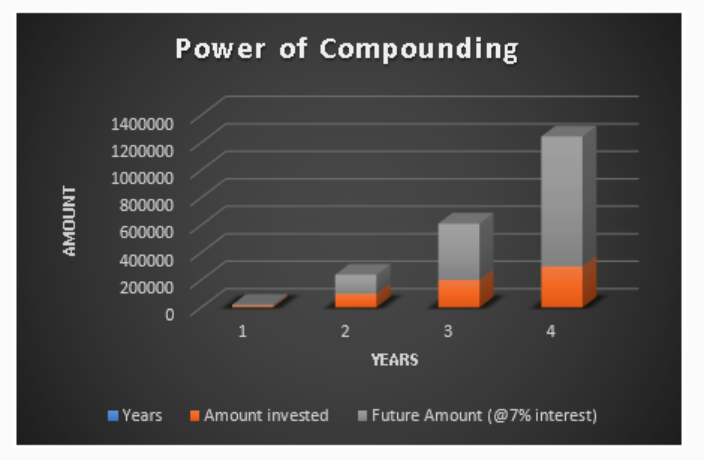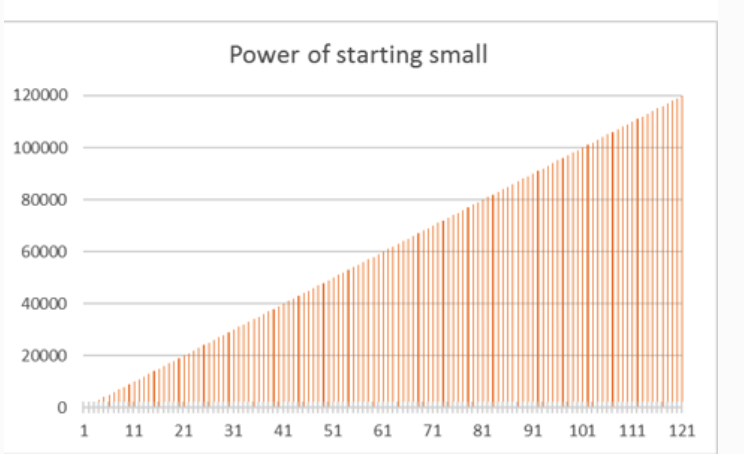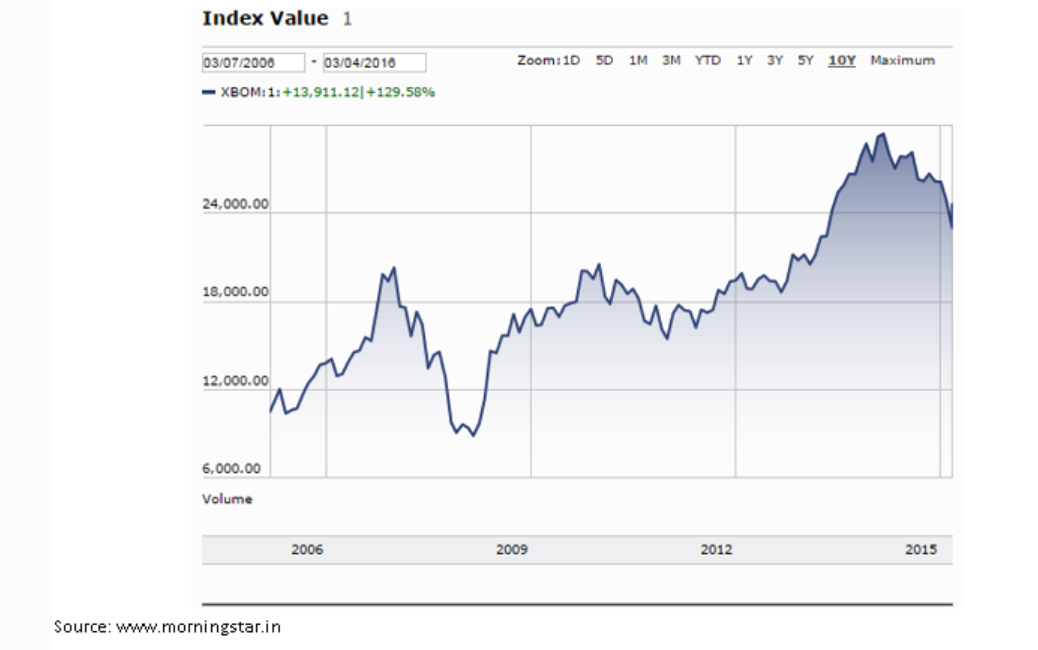SIP Investments versus Lumpsum
| Systematic Investment Plans – are they better than lumpsum investments? A case study | ||||||||||
| A Systematic Investment Plan enables you to build a portfolio over a longer time horizon with small investments at regular intervals. This reduces the risk of market volatility as compared to investing a lumpsum amount at one go. One can choose between Quantity based and Amount based SIPs in Stocks, Mutual Funds, ETFs and Gold. Here we are analysing SIP investments in equity mutual funds and whether they are a better investment option than a one-time lumpsum investment. |
||||||||||
| Types of SIP | ||||||||||
| There are three types of SIP currently available in the market today | ||||||||||
| Amount based SIP | ||||||||||
| This is a fixed amount decided by the investor that is invested in a selected share/ units of a mutual fund at pre defined frequency. | ||||||||||
| Let us assume an investment of Rs 5000 each month for12 months across 2014 ending December 2014. This is the value of the investment at the end of the period if it had been invested in one of the better performing large cap equity funds – SBI Blue Chip (growth) | ||||||||||
| As of Date | NAV(Rs) | No of Installments | Invested Amount(Rs) | Investment Value (Rs) | % gain | |||||
| 12/31/2014 | 26.64 | 12 | 60,000.00 | 73,477.33 | 22.46 | |||||
| Source: www.morningstar.in | ||||||||||
| Quantity based SIP | ||||||||||
| This is a fixed quantity of shares/ units of the desired company/ mutal fund that is purchased at pre defined frequency. | ||||||||||
| Let us assume a purchase of 200 units of SBI Blue Chip Growth on the 10th of each month. This is the value of the investment if it had been invested in 2014. | ||||||||||
| Date of investment | NAV(Rs) | Units | Investment Value (Rs) | |||||||
| 1/10/2014 | 17.87 | 200 | 3,574.00 | |||||||
| 2/10/2014 | 17.58 | 400 | 7,032.00 | |||||||
| 3/10/2014 | 18.76 | 600 | 11,256.00 | |||||||
| 4/10/2014 | 19.45 | 800 | 15,560.00 | |||||||
| 5/12/2014 | 20 | 1000 | 20,000.00 | |||||||
| 6/10/2014 | 22.25 | 1200 | 26,700.00 | |||||||
| 7/10/2014 | 22.67 | 1400 | 31,738.00 | |||||||
| 8/11/2014 | 22.96 | 1600 | 36,736.00 | |||||||
| 9/10/2014 | 24.97 | 1800 | 44,946.00 | |||||||
| 10/10/2014 | 24.44 | 2000 | 48,880.00 | |||||||
| 11/10/2014 | 26.09 | 2200 | 57,398.00 | |||||||
| 12/10/2014 | 26.36 | 2400 | 63,264.00 | |||||||
| Source: www.morningstar.in | ||||||||||
| Flexi SIP | ||||||||||
| Here, the investor will be required to specify a regular amount and a maximum amount of investment per month. The monthly investment can thereafter vary from the minimum required for that mutual fund scheme and the user specified maximum amount. The investor can change the investment amount on a monthly basis or alternatively choose not to change it for a particular month. | ||||||||||
| Flexi SIP are used by two classes of investors: | ||||||||||
| Investor Type | Benefit | |||||||||
| Beginner investor | With Flexi SIP, they can increase or reduce the monthly amount to suit their affordability. | |||||||||
| Financially Savvy investor | If they feel the markets are too high in a month, they can reduce the SIP amount or if they feel the market is undervalued, they can increase it. This enables them to aim for a better average market price for their investments. | |||||||||
| Advantages of SIP | ||||||||||
| 1 | Power of compounding | |||||||||
| Assume an investment of Rs 10000 annually with a interest of 7% for 10 years. The future value of such an investment will be Rs 1.38 lakh. | ||||||||||
| If the person had invested for 20 years, the future value will rise to 4 lakhs, thereby showing the power of compounding | ||||||||||
| Years | Amount invested | Future Amount (@7% interest) | ||||||||
| 1 | Rs. 10,000.00 | Rs. 10,000.00 | ||||||||
| 10 | Rs. 100,000.00 | Rs. 138,164.48 | ||||||||
| 20 | Rs. 200,000.00 | Rs. 409,954.92 | ||||||||
| 30 | Rs. 300,000.00 | Rs. 944,607.86 | ||||||||
 |
||||||||||
| 2 | Power of starting small | |||||||||
| Assume a person saves Rs 1000 each month for 10 years. At the end, his saving would have amounted to Rs 120000. Thus, one can see how a small figure saved over time can add up to huge sums.
|
||||||||||
| 3 | Rupee Cost Averaging | |||||||||
| The major advantage of SIP is that one does not need to time the market. The small regular investments allow one to average out the market volatility. Considering a long term investment approach, rupee cost averaging can even out any market ups and downs in the long term, allowing the investor to gain maximum benefits on his investments over time. | ||||||||||
| Investment amount | NAV | Units | ||||||||
| 5000 | 20 | 250.00 | ||||||||
| 5000 | 10 | 500.00 | ||||||||
| 5000 | 16 | 312.50 | ||||||||
| 5000 | 20 | 250.00 | ||||||||
| 5000 | 25 | 200.00 | ||||||||
| 5000 | 22 | 227.27 | ||||||||
| Total Units and average cost | 18.8 | 1,739.77 | ||||||||
| From the above, we can see that the number of units purchased rises whenever the market falls, thus reducing the overall cost of purchase. | ||||||||||
| 4 | Value Cost Averaging | |||||||||
| Value Cost Averaging (VCA) is an investment technique where investments are made systematically over a period of time, but the quantum of investment in VCA changes depending on market fluctuation. | ||||||||||
| VCA fixes a target amount each month, and ensures this target amount is maintained every month, irrespective of the market price. Therefore, the investor, buys or sells, only those units that are required to maintain the predestined portfolio worth at each revaluation point, which is typically every month | ||||||||||
| Therefore, the simple principal is, in falling markets, one buys more units and in rising markets, one buys fewer units or may even require to sell some units to maintain the target portfolio amount. | ||||||||||
| In the illustration below, it can be seen how value cost averaging helps in: 1. reducing average costs , 2. reducing portfolio volatility, 3. achieving goal based taget values. |
||||||||||
| Month | NAV | Target Portfolio amount | Cumulative units | Units Purchased/ Sold | Amount Invested per month | |||||
| 1 | 10 | 1000 | 100 | 100 | 1000 | |||||
| 2 | 12 | 2000 | 166.67 | 66.67 | 800 | |||||
| 3 | 16 | 3000 | 187.5 | 20.83 | 333 | |||||
| 4 | 12 | 4000 | 333.33 | 145.83 | 1750 | |||||
| 5 | 17 | 5000 | 294.11 | -39.22 | -666.74 | |||||
| 6 | 15 | 6000 | 400 | 106 | 1590 | |||||
| Total Amount Invested | 13.66 | 6000 | 400 | 400 | 4807 | |||||
| Average cost per unit | 12.01 | |||||||||
| Factual examples | ||||||||||
| The Sensex has had a roller coaster ride over the past decade. There was a major crash in 2008/09 and a surge in 2014/15. | ||||||||||
 |
||||||||||
| When there is a bull market , SIP is a clear winner over lumpsum investment | ||||||||||
| If a person had invested Rs 10000 in early 2015, when the sensex was at its peak, he would not have received as many units as if he had invested gradually over a period of time. | ||||||||||
| Let us assume a regular Rs 1000 montly investment in ICICI Prudential Value Discovery Fund, a multicap fund from March 2013 to March 2015 | ||||||||||
 |
||||||||||
| Date | Price | Cumulative | Investment | |||||||
| (dd/mm/yyyy) | (INR) | Units | Value(INR) | |||||||
| 3/1/2013 | 54.38 | 18.39 | 1,000.00 | |||||||
| 4/1/2013 | 54.02 | 36.9 | 1,993.38 | |||||||
| 5/2/2013 | 55.32 | 54.98 | 3,041.35 | |||||||
| 6/3/2013 | 54.39 | 73.36 | 3,990.22 | |||||||
| 7/1/2013 | 51.95 | 92.61 | 4,811.22 | |||||||
| 8/1/2013 | 48.98 | 113.03 | 5,536.16 | |||||||
| 9/2/2013 | 49.81 | 133.11 | 6,629.97 | |||||||
| 10/1/2013 | 52.85 | 152.03 | 8,034.61 | |||||||
| 11/1/2013 | 57.92 | 169.29 | 9,805.39 | |||||||
| 12/2/2013 | 59.32 | 186.15 | 11,042.39 | |||||||
| 1/1/2014 | 62.58 | 202.13 | 12,649.24 | |||||||
| 2/3/2014 | 58.87 | 219.12 | 12,899.34 | |||||||
| 3/3/2014 | 62.03 | 235.24 | 14,591.75 | |||||||
| 4/1/2014 | 68.38 | 249.86 | 17,085.50 | |||||||
| 5/2/2014 | 71.39 | 263.87 | 18,837.59 | |||||||
| 6/2/2014 | 84.96 | 275.64 | 23,418.28 | |||||||
| 7/1/2014 | 90.77 | 286.66 | 26,019.75 | |||||||
| 8/1/2014 | 91.65 | 297.57 | 27,272.00 | |||||||
| 9/1/2014 | 98.11 | 307.76 | 30,194.29 | |||||||
| 10/1/2014 | 99.49 | 317.81 | 31,618.99 | |||||||
| 11/3/2014 | 103.5 | 327.47 | 33,893.41 | |||||||
| 12/1/2014 | 106.3 | 336.88 | 35,810.34 | |||||||
| 1/1/2015 | 108.3 | 346.11 | 37,484.10 | |||||||
| 2/2/2015 | 114.6 | 354.84 | 40,664.61 | |||||||
| 3/2/2015 | 117.89 | 363.32 | 42,832.04 | |||||||
| Source: www.valueresearchonline.com | ||||||||||
| The investment value has risen to Rs 42832 while cost is Rs 25000 | ||||||||||
| If the Rs 25000 had been invested as a lumpsum on October 2014 in the same fund, the value will be much lower. | ||||||||||
| Date | Price | Cumulative | Investment | |||||||
| (dd/mm/yyyy) | (INR) | Units | Value(INR) | |||||||
| 10/1/2014 | 99.49 | 251.28 | 25,000.00 | |||||||
| 3/2/2015 | 117.89 | 251.28 | 29,623.58 | |||||||
| When there is a bear market, SIP again gains over lumpsum investment | ||||||||||
| If a person had invested Rs 1000 monthly for 18months from Nov 2008 till April 2010 through an SIP, despite a sensex crash, he would still be better off than investing in a lumpsum. | ||||||||||
| Date | Price | Cumulative | Investment | |||||||
| (dd/mm/yyyy) | (INR) | Units | Value(INR) | |||||||
| 11/3/2008 | 16.93 | 59.07 | 1,000.00 | |||||||
| 12/1/2008 | 14.96 | 125.91 | 1,883.64 | |||||||
| 1/1/2009 | 17.63 | 182.63 | 3,219.82 | |||||||
| 2/2/2009 | 16.11 | 244.71 | 3,942.22 | |||||||
| 3/2/2009 | 15.37 | 309.77 | 4,761.14 | |||||||
| 4/1/2009 | 16.9 | 368.94 | 6,235.08 | |||||||
| 5/4/2009 | 20.93 | 416.72 | 8,721.91 | |||||||
| 6/1/2009 | 26.97 | 453.8 | 12,238.89 | |||||||
| 7/1/2009 | 27.47 | 490.2 | 13,465.79 | |||||||
| 8/3/2009 | 31.78 | 521.67 | 16,578.55 | |||||||
| 9/1/2009 | 34.01 | 551.07 | 18,741.86 | |||||||
| 10/1/2009 | 36.69 | 578.32 | 21,218.73 | |||||||
| 11/3/2009 | 34.98 | 606.91 | 21,229.79 | |||||||
| 12/1/2009 | 38.54 | 632.86 | 24,390.40 | |||||||
| 1/4/2010 | 40.85 | 657.34 | 26,852.31 | |||||||
| The investment of Rs 18000 had increased to Rs 26852 | ||||||||||
| If the Rs 18000 had been invested as a lumpsum in August 2009 in the same fund, the value would have risen to just Rs 23137 in April 2010 | ||||||||||
| Date | Price | Cumulative | Investment | |||||||
| (dd/mm/yyyy) | (INR) | Units | Value(INR) | |||||||
| 8/3/2009 | 31.78 | 566.39 | 18,000.00 | |||||||
| 1/4/2010 | 40.85 | 566.39 | 23,137.19 | |||||||
| Source: www.valueresearchonline.com | ||||||||||
| Myths of SIP investing | ||||||||||
| 1 | Timing is crucial | |||||||||
| Timing is not a crucial element in SIP investment since the gradual investment over time often limits the exposure to market volatility. However, it must be noted that in a continuously falling market, the returns will be lower. In addition, if one has started investing when there was a bull market, which later started falling, it will take some time to recover the losses. In the long term ( a period exceeding 10 years), SIP will almost always be a better option than lumsum investments. | ||||||||||
| 2 | SIP always gives better returns than lump sum investment | |||||||||
| In a bull market when the Sensex is rising, there are situations when lumpsum investment will fetch higher returns, out performing an SIP. Nonetheless, SIP is te better option as most investors cannot time the market or invest large lumpsums in one go. In such scenarios, SIP should be the preferred mode of investment. | ||||||||||
| Conclusion | ||||||||||
| An SIP does not guarantee returns or ensure positive returns. If you opt for an SIP in a falling market and the market continues to fall as it happened last year, then your investment will suffer a loss on the whole. Despite this, over the long term, investing in a SIP provides an investor a great way to regularly make investments and grow small savings into a tidy nestegg for the future. | ||||||||||
| Neena Shastry | ||||||||||
| Research Desk- Dilzer Consultants Pvt Ltd | ||||||||||
18 March 2016

